Our project was an entire promotional package for a new rock music album by the band AFI, with the central focus being on creating a promotional music video for the first single for the album to be sent out to all major music video channels (MTV, Kerrang!, Scuzz, etc.). Within this, there were many conventions of existing music videos that we followed, but equally, there are also certain conventions that we challenged in order to create something unique and truly set it that much apart from videos and media products typical of the rock music genre. We were careful to balance this line between following established conventions and breaking away a little and doing our own thing, and I'm very happy to report that, in my opinion, I believe we achieved this well. I will look at a number of different shots from the video which illustrate this, starting with the first one below. I will also draw in other shots from throughout the video which are similar or help illustrate the point, as well as shots from existing music videos of the genre, to show how we have either followed or challenged existing conventions.
To start, lets have a look at this shot of the microphone from the very start of the video. 
A shot of solely the microphone is a classic shot featured in many rock performance videos, and is often used, occasionally with shots of the equipment around the band, to set the scene and introduce to the viewer that it will be a performance video. It also gives the mise-en-scene (in this case, the equipment) a certain energy about it, and a sense of anticipation that, at any second, the performance will kick in and the performers (which we haven't seen directly yet in the video) will crash into life. Below is another shot taken from the start of our video, this time of the guitarist's amp from a high-angle shot.

A shot of solely the microphone is a classic shot featured in many rock performance videos, and is often used, occasionally with shots of the equipment around the band, to set the scene and introduce to the viewer that it will be a performance video. It also gives the mise-en-scene (in this case, the equipment) a certain energy about it, and a sense of anticipation that, at any second, the performance will kick in and the performers (which we haven't seen directly yet in the video) will crash into life. Below is another shot taken from the start of our video, this time of the guitarist's amp from a high-angle shot.

In this shot, the colour overlay effect can really be evidenced for the first time, giving the concrete floor a really cold feel to it, which matches back to our genre of music - not necessarily the rock music genre, but more the goth music genre, of which AFI are a part of. Below are two examples of using the microphone shot I explained above in existing videos, the first shot being from AFI's 'Medicate' video, and the second taken from the music video to The Offspring's 'Gone Away'.

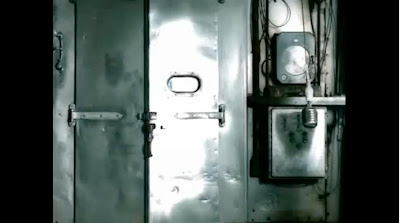
Next, I will take a look at several shots of the lead singer. It is a common convention of music videos across the genres that the record companies often demand lots of shots of the lead singer in a band, sometimes to the detriment of the rest of the band. The point of this is that the lead singer is often the main focal point of the band to the media and in promotion, so heavy exposure of him is often requested in videos. Below is one shot in particular of the singer.
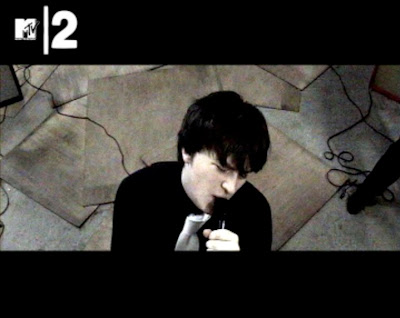
This shot demonstrates several key conventions. Not only does it follow the convention I outlined a moment ago, but it also uses several others, chief of which is that of the singer showing real emotion in his or her singing. As you can see here, the singer is so immersed in the song itself that his eyes are closed and he gives a sense that he is almost lost in the song itself, further emphasised by his body language as he clutches the microphone. Below is another shot showing an example of the energy exuding from the singer, as he moves his body frantically in time to the music.
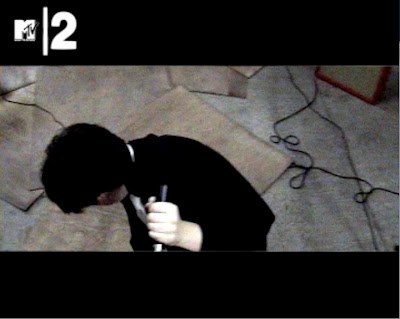 Also, the high-angle shot down onto the singer is a classic rock music camera angle, and it allows the viewer to show the movement and energy of the singer well. Below are several examples of this, including another shot from the 'Medicate' video, and two other examples: Foo Fighters' 'All My Life' and The Offspring's 'Can't Get My Head Around You', two other modern rock music videos.
Also, the high-angle shot down onto the singer is a classic rock music camera angle, and it allows the viewer to show the movement and energy of the singer well. Below are several examples of this, including another shot from the 'Medicate' video, and two other examples: Foo Fighters' 'All My Life' and The Offspring's 'Can't Get My Head Around You', two other modern rock music videos. 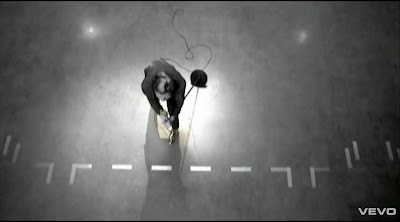
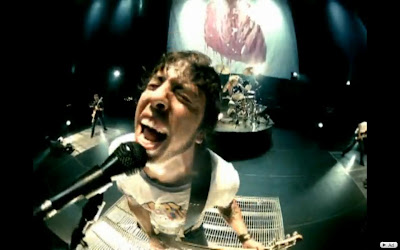
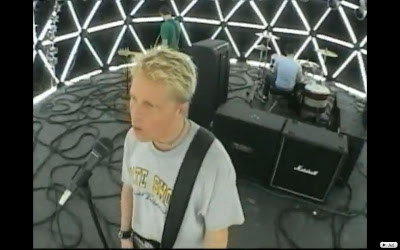
What these shots of the singer also show are the wooden boards that we laid on the floor for the shooting, and they really come into the fore in these high-angle shots. They further emphasise the already gritty, quite cold look that has been achieved by the grey concrete of the floor and the colour overlay we implemented. Also, leads and other equipment are sighted in the background of these shots, which gives the viewer a certain spacial awareness - it demonstrates the size of the area that the band are performing in, and by keeping the band relatively close together, it shows an intimacy, unity and tightness to the band and their performance. Below is another high-angle shot which demonstrates this well, showing the drummer and other members.
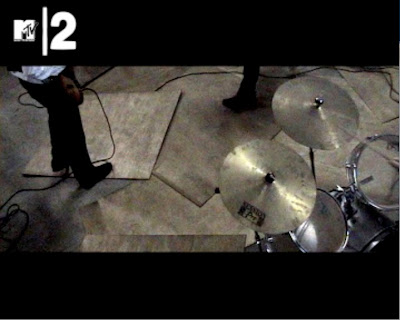
Another shot relating to the singer is this shot here, showing a close up of the singer and in particular, his mouth. This is another relatively common technique, and further emphasises the emotion and energy evident in the singer's performance. However, we did go against this convention to a certain degree, as it is often more common to show the whole face in a portrait format - in our video, however, we show mainly the mouth, along with parts of the upper body, in order to show the flamboyant movement of the singer's arm in time to the lyrics and the song.
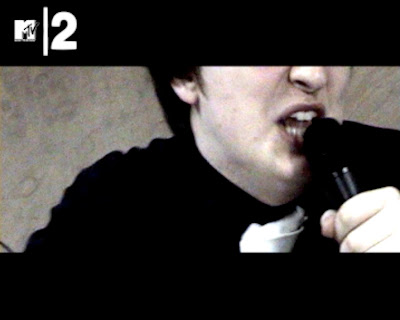
Emotion is prevalent in the other performers too, as this shot of the bassist shouting backing vocals with real vigour demonstrates. This helps to add to the backing vocals and give them more size and energy than normal, even though there is no actual difference to the backing vocals on the song. It embellishes them with more energy, and it keeps a unity to the band by using a similar camera angle as the singer. Below is the shot in question, and below that is an example of this technique in the video for AFI's song 'Miss Murder', where the bassist is shown furiously shouting the 'Hey!' in the chorus section.
This concludes Part 1 of Question 1.



No comments:
Post a Comment